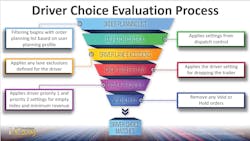McLeod’s Driver Choice tool aims to give drivers what they want
DENVER. What do drivers want? That’s an open question to any fleet manager. But McLeod Software wants to help carriers find an answer with software that makes it easier for fleets to pair the right loads with the right drivers.
LoadMaster Driver Choice aims to help fleets understand owner-operators and company drivers’ preferences. In turn, that could help those fleets attract and retain the best drivers and best relationships with independent drivers.
Tom McLeod, the company CEO and president, touted the benefits of the new program as “a very powerful tool that gets drivers engaged with your company” at the start of the McLeod Software User Conference 2019 on Aug. 26, at the Gaylord Rockies.
One large carrier started using Driver Choice earlier this year before it was officially released this summer.
“We invited them to present here at the conference,” McLeod recalled during a roundtable discussion with industry media. “They said, ‘We want you to be successful but this is so much of a competitive advantage for us right now that we don’t want anyone know how well this is working.’”
The Driver Choice software gives carrier drivers real and visible input in the types of loads they want. It allows drivers to preselect their load preferences. Then planners, dispatchers, and driver managers can assign or, in some cases, give the driver a choice of loads that best fit each driver.
“In our experience, the drivers love that — having some input and choice,” McLeod said during the conference’s opening remarks on Monday. “We save the loads the driver picked and the loads the driver didn’t pick so you can go over them later with the driver.”
If the company chooses, drivers can be authorized to make their own load choices and self-dispatch their next load from those the carrier offers using remote access through a web portal or the McLeod Driver App.
This was created for fleets with a high percentage of owner-operators because it also documents the owner operator’s choice to accept or refuse any load. But McLeod said he was surprised there was also a lot of interest in Driver Choice by fleets with more company drivers.
“So we’ve added some reconfigurability with the product so the company driver has more limited options than the owner-operator,” he said. “But you are still more fully accommodating the drivers by skill level and preferences for the type of freight handled. So all your dispatchers don’t have to memorize the preferences of all the drivers.”
The system allows for the dispatcher, driver manager, or driver to view the best next load based on the driver's priorities of minimum revenue or empty distance. Additional preferences can be set at the driver level for commodities, equipment types, dropping trailers, and preferred lanes. The system allows for requested driver exclusions, such as regions, states, or locations as well. Once a driver’s preferences are stored, a dispatcher, dispatch manager, or an actual driver (if allowed) can search matched available for dispatch loads directly from LoadMaster.
The top matched loads can be offered to a driver in several ways and selected for pre-assignment. These offered loads are screened by filters set up by the carrier and checked with McLeod’s Driver Feasibility function to ensure that this driver can complete the load efficiently. This means the driver physically has the available hours of service (HOS) and can deliver it based on their current location, load delivery window, and the estimated time of arrival for both their current load and the empty move to pick up that next load within the appointment time.
Driver Choice presents a dispatcher or planner with a list of top five available movements matching the driver’s preferences to identify the best load for the driver’s next assignment. The list is filtered based on company rules and driver preferences. Once the driver assigns himself/herself to the load, or the planner assigns them, the load is no longer available for other planners to offer.
About the Author
Josh Fisher
Editor-in-Chief
Editor-in-Chief Josh Fisher has been with FleetOwner since 2017. He covers everything from modern fleet management to operational efficiency, artificial intelligence, autonomous trucking, alternative fuels and powertrains, regulations, and emerging transportation technology. Based in Maryland, he writes the Lane Shift Ahead column about the changing North American transportation landscape.



